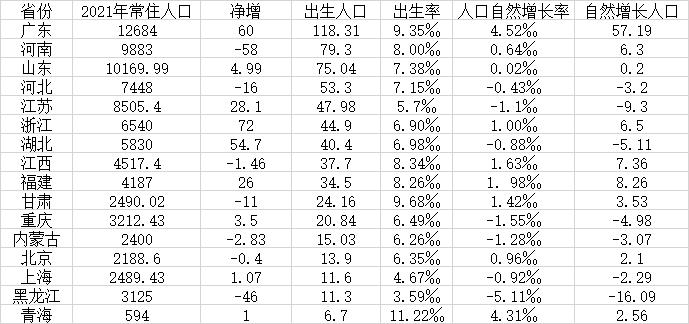After the National Bureau of Statistics released the population data in 2021, local data were released one after another.
According to the statistics of the First Financial Reporter, up to now, 21 provinces have released the data of permanent residents in 2021. Among them, 16 provinces released data on the birth population in 2021. Among these 16 provinces, Guangdong, the largest economic province, ranks first, with a population of 1,183,100. The birth population in Shandong has dropped by nearly 60% in the past five years, and the birth population in Jiangsu has fallen below 500,000 for the first time in 44 years. In addition, the growth rate of resident population in seven provinces is negative.
It is worth noting that although only 16 provinces have released the data of the population born in 2021, according to the data of the past few years, Guangdong, Henan and Shandong, three populous provinces with a permanent population of 100 million, have been in the top three. At present, the birth population data of these three provinces have been released. From the available data, the birth population data of Guangdong ranks first in the country for three consecutive years.

16 provinces that have published birth population data (population unit: 10,000 people. Source of data: First Financial Reporter compiled according to public data in various places)
Niu Fengrui, a researcher at the Center for Urban Development and Environment Research of China Academy of Social Sciences, analyzed the First Financial Report. The high birth rate in Guangdong is largely related to the influx of people from Guangdong. Because the influx of people is mainly young and middle-aged, the population of childbearing age is particularly large. In addition, it is also related to the fertility will of Chaoshan and other places in Guangdong, with high fertility will and relatively high birth rate.
Guangdong was also the only province in China where the birth population exceeded 1 million last year. After Guangdong, Henan and Shandong ranked second and third, with a birth population of 793,000 and 750,400 respectively.
Among them, since 2016, the population born in Shandong, the third largest economic province, has changed greatly. In 2016, the population born in Shandong was 1,770,600, ranking first in the country, equivalent to 1/10 of the country, with 534,800 more births than the previous year; Among them, the birth rate of two children reached 63.3%, far exceeding that of one child. Shandong has also become the "most daring to have two children" province in China. In the following years, with the weakening of the universal two-child policy effect, the birth population in Shandong decreased rapidly, and in 2021 it was only 42.4% in 2016, which means that the birth population in Shandong decreased by 57.6% in the past five years.
The birth population in Hebei has also exceeded the 500,000 mark, reaching 533,000. The birth population of Jiangsu, the second largest economic province, is 479,800, which is only 40% of that of Guangdong. This is the first time that the birth population of Jiangsu has fallen below the 500,000 mark in 44 years (Jiangsu Statistical Yearbook 2021 published the data of birth population from 1978 to 2020).
In terms of the birth rate of permanent residents, only 6 of the 16 provinces are higher than 7.52‰ The national average. They are Qinghai, Gansu, Guangdong, Jiangxi, Fujian and Henan, all of which have reached or exceeded eight thousandths. Among them, Qinghai has exceeded 1%, that is, ten thousandths.
Generally speaking, the places with high birth rate are mainly concentrated in the west, south China and Henan and Jiangxi in the middle. Generally speaking, places with high birth rate are often places with low urbanization rate. However, two provinces with developed economy and high urbanization rate, such as Guangdong and Fujian, are influenced by traditional clan culture and other factors, and their fertility will is relatively high. For example, Chaoshan in Guangdong and Minnan in Fujian have relatively high fertility wishes.
"There are still quite a few people in our hometown who want to have three children." Mr. Bai, whose hometown is Anxi County, Quanzhou City, and currently works in Xiamen, has given birth to two daughters. Previously, because his wife was working in a public institution, the plan to give birth to three children could only be shelved. After the implementation of the three-child policy last year, the couple began to plan to have three children.
In contrast, the places with low birth rate mainly come from Northeast China, North China, Yangtze River Delta and Chongqing with high urbanization level. Among them, the birth rates in Jiangsu, Shanghai and Heilongjiang provinces are all below six per thousand. The birth rate in Heilongjiang is only 3.59‰ .
While the birth rate is low, the number of provinces with negative natural population growth rate is also increasing. The first financial reporter combed and showed thatOf the 16 provinces, 7 have negative natural population growth rates. Including Hebei, Hubei, Chongqing, Inner Mongolia, Jiangsu, Shanghai and Heilongjiang. Among them, the natural population growth rate of Heilongjiang in 2021 is -5.11‰ , the lowest in the country. Jiangsu, Hubei and Inner Mongolia all turned negative for the first time in recent decades.
关于作者